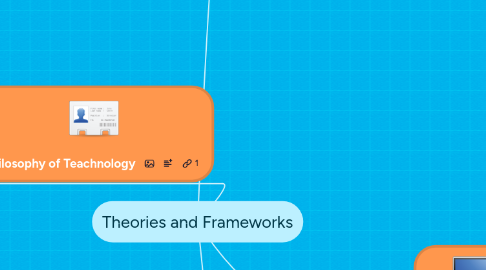
1. Philosophy of Teachnology
1.1. Teachers personal philosophy about how they use technology as a teaching tool
1.1.1. How do I want to teach with technology?
1.1.2. How do I view technology and how can I incorporate technology into the classroom?
1.1.3. Can I assess learning with technology?
1.1.4. Can I assess my own teaching with technology?
1.1.5. Do I have technological knowledge?
1.1.6. What are the benefits to using technology in the classroom?
1.1.7. What are the limitations to using technology in the classroom and how can I overcome these?
2. 21st Century Learning Model
2.1. Foundational Knowledge
2.1.1. Content, information literacy, cross-disciplinary knowledge
2.2. Meta Knowledge
2.2.1. Problem-solving/critical thinking, communication/collaboration, creativity
2.3. Humanistic Knowledge
2.3.1. Life/job skills, cultural competence, ethical/emotional awareness
3. TPACK
3.1. Content Knowledge
3.1.1. Knowledge about the actual subject matter that is learned or taught
3.1.1.1. Understand subjects to be taught
3.1.1.1.1. Central facts
3.1.1.1.2. Concepts
3.1.1.1.3. Theories
3.1.1.1.4. Procedures
3.1.1.2. Knowledge of explanatory frameworks that organize and connect ideas
3.1.1.3. Knowledge of the rules of evidence and proof
3.1.1.4. Understand nature of knowledge and inquiry in different fields
3.2. Pedagogical Knowledge
3.2.1. Deep knowledge about the process and practices or methods of teaching and learning and how it encompasses overall educational values, aims and purposes
3.2.1.1. Student learning
3.2.1.2. Classroom management
3.2.1.3. Lesson plan development and implementation
3.2.1.4. Student evaluation
3.2.1.5. Knowledge about the techniques or methods to be used in the classroom
3.2.1.6. Nature of the target audience
3.2.1.7. Understand how students construct knowledge and acquire skills
3.2.1.8. Understand how students develop habits of mind and positive attitudes to learning
3.2.1.9. Knowledge of social, cognitive and developmental theories of learning and how to implement in the classroom
3.3. Technological Knowledge
3.3.1. Knowledge about standard technologies such as books and chalk and blackboard and also more advanced technologies such as Internet and digital video
3.3.1.1. Knowledge of operating systems and computer hardware
3.3.1.2. Ability to use standard software tools
3.3.1.2.1. Examples: E-mail, Word, web-browsers
3.3.1.3. Knowledge on upgrading and installing sofrware
3.3.1.4. Maintaining data archives
3.3.1.5. Staying up to date on technology and always in the loop
4. SAMR
4.1. How technology might impact teaching and learning
4.1.1. TRANSFORMATION
4.1.1.1. Redefinition
4.1.1.1.1. Technology allows for creation of new tasks, previously impossible
4.1.1.1.2. Example: classroom creates a documentary video with groups creating different parts to contribute to one final project
4.1.1.2. Modification
4.1.1.2.1. Technology serves for significant task redesign
4.1.1.2.2. Example: an audio recording of an essay is made which is performed in front of an authentic audience
4.1.2. ENHANCEMENT
4.1.2.1. Augmentation
4.1.2.1.1. Technology acts as a direct tool substitution
4.1.2.1.2. FUNCTIONAL IMPROVEMENT
4.1.2.1.3. Example: students take a quiz online instead of with paper and pencil
4.1.2.2. Substitution
4.1.2.2.1. Technology acts as a direct tool substitution
4.1.2.2.2. NO FUNCTIONAL CHANGE
4.1.2.2.3. Example: students print out a worksheet, fill it out and hand it in
